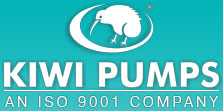
Pumps Information » Magnetic Drive Pumps
Magnetic Drive Pumps
Magnetic Drive Pumps are sealless pumps that use a coaxial magnetic coupling to transmit torque to an impeller. A standard electric motor drives a set of permanent magnets that are mounted on a carrier or drive assembly. In turn, the magnets drive the inner rotor and provide the no-slip or synchronous capability of the torque coupling. There are two basic types of magnetic drive pumps: rotating driven shaft and stationary shaft. Rotating shaft magnetic drive pumps are usually made of metal and include a pressurized recirculation circuit to help prevent vaporization of the liquid required to lubricate the bearings. Stationary shaft magnetic drive pumps typically use non-metallic components such as ceramics and plastics and are best suited for light to medium duty applications.
Magnetic drive pumps are capable of pumping a variety of liquids. Some devices are designed to move abrasive materials, acids, adhesives, chemicals, concrete and grout, coolants, hazardous materials, liquid metal, or lubricants. Other devices are rated for combustible, corrosive, high viscosity, or high temperature media. Magnetic drive pumps are also used to move gasoline, diesel fuel, and oil; ground water, potable water, salt water, and wastewater; sewage, sludge, slurry and ash slurry; gas and air; powders, solids, and rendering wastes; and a variety of liquids and liquids with solids. Important specifications for magnetic drive pumps include maximum discharge flow, maximum discharge pressure, inlet size, discharge size, and media temperature. Power sources include compressed air, gasoline, diesel fuel, solar energy, alternating current (AC), and direct current (DC). Small DC-powered magnetic drive pumps operate on 6, 12, 24, or 32 volts. Single-phase motors require 100, 115, 200, or 230 volts. Three phase motors run at voltages that range from 230 VDC to 460 VDC, and from 480 VDC to 690 VDC. Pumps that do not include a power source typically provide a drive shaft for connection to a motor.
Manually powered pumps rely upon hand or foot power.Magnetic drive pumps are used in a variety of commercial, industrial, municipal, and maritime applications. Examples include agriculture and horticulture, dairy farms, breweries and distilleries, construction, flood control, food service and food processing, power generation, and oil and gas production. Magnetic drive pumps are also used in the aerospace and defense, automotive, machine tool, mining, medical, pharmaceutical, semiconductor, and paper industries. Devices for heating, ventilation and air conditioning (HVAC) systems are also available. Cryogenic pumps are rated for conditions where temperatures are low enough for gases to condense to become liquids or solids. Petrochemical and hydrocarbon pumps are rated for materials such as gasoline, kerosene, diesel oil, lubricating oil, paraffin wax, and asphalt.
